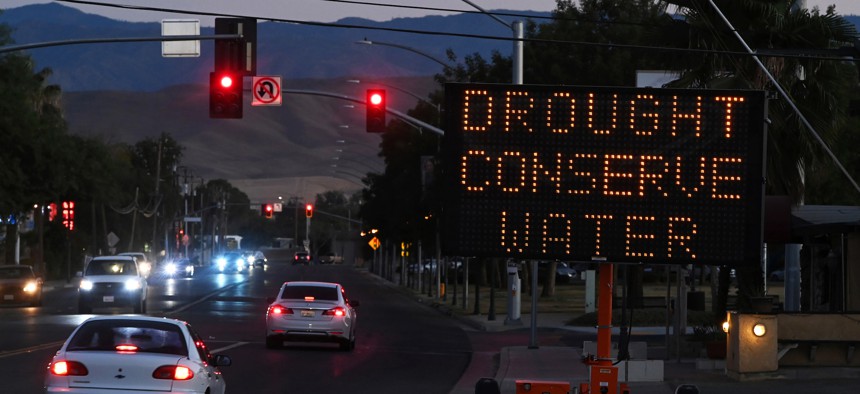A New Strategy for Western States to Adapt to Long-term Drought: Customized Water Pricing

Matt McClain/The Washington Post via Getty Images
Even after January’s storms, California faces a water-scarce future. An economist and an engineer propose a way to test higher water prices as a conservation strategy without hurting low-income users.
This article is republished from The Conversation under a Creative Commons license. Read the original article.
Even after heavy snow and rainfall in January, western states still face an ongoing drought risk that is likely to grow worse thanks to climate change. A whopping snowpack is good news, but it doesn’t reduce the need for long-term planning.
Confronted with a shrinking supply of water for agriculture, industry and residential uses, water agencies have pursued different strategies to encourage water conservation. They have nudged customers to reduce water use, limited outdoor watering and offered incentives to rip out lawns. On the supply side, there are innovative ideas about using heavy rains to recharge groundwater.
Basic economics teaches us that a higher price for water would encourage conservation. Up until now, however, concerns about harming low-income households have limited discussions about raising water prices to reduce demand.
We know that it’s hard to pay more for essential goods such as food, energy and water, especially for lower-income households. Rather than raising everyone’s water prices, we propose a customized approach that lets individual consumers decide whether to pay higher prices.
Who is most able and willing to conserve?
One of the most common challenges involved in making markets work well is what economists call asymmetric information – when one party has more access to relevant information than the other party. Think about buying or selling a car before online tools like Carfax were available. Owners and dealers knew more about what each car was really worth, so they had greater bargaining power than buyers.
The West has millions of water users with a broad range of incomes who consume water at widely varying levels. These consumers, including urban households, businesses and farmers, know more than water agencies do about how readily they can conserve water.
For example, a person who owns a home with a large green lawn and who is conservation-minded may need only a small incentive to switch to native, low-water plants. Some farmers may need only a small incentive to replace water-intensive alfalfa production with a less water-intensive crop.
Water agencies could elicit this private information by making a “take it or leave it” offer to water consumers. Some of California’s electric utilities have already experimented with this opt-in approach to encourage energy conservation.
Target the big users
Every western water district has access to customer-level big data on monthly and even daily water consumption. Agencies could use this information to identify the top 10% of water consumers in their territories, based on volume used – like the household in the Bel Air neighborhood of Los Angeles that used 11.8 million gallons of water in 2014.
Water agencies could randomly select customers among the largest water users in their service areas to participate in a small pilot study. Each invitee would receive an opt-in contract offering to pay them an annual fee for enrolling for three years in a water conservation program. In return, the price the consumer paid for each gallon of water would triple. This approach would give the consumer a guaranteed payment for participating and a clear incentive to use less water.
Data scientists would collect information on who accepted the offer and could survey invitees to learn how they decided whether or not to participate. Combining these two data sets would make it possible to test hypotheses about which factors determined willingness to accept the opt-in offer.
Using customer-level water consumption data over time, water agencies could track usage and compare customers who participated in the price increase program with others who turned down the offer. This would make it possible to estimate the water conservation benefits of introducing customized water prices.
There are many different ways in which water users could cut back, including swapping out old appliances or watering their gardens less often. Farmers could install more efficient irrigation systems. Customers who chose the payment in return for higher prices would decide which conservation strategies worked best for them.

Big potential insights
Conducting a pilot study using a randomly chosen sample of high-usage customers is a low-stakes strategy. If it fails to promote water conservation at a low cost, then a valuable lesson has been learned. If it succeeds, the same opt-in offer could be made to more high-usage customers.
Water agencies would need funds to support the pilot study, possibly from state or federal sources. Since pumping, treating and heating water uses energy, and thus creates greenhouse gas emissions, funds from the Inflation Reduction Act might be an option. Successful water conservation would help to slow climate change.
Today, most water agencies don’t know how responsive individual customers would be to higher prices. By conducting the type of pilot study that we have described, agencies could answer that question without raising prices for vulnerable households. If such initiatives succeeded, they could be replicated in other drought-prone areas of the West. Since farms consume the largest share of water in western states, it is especially important to learn more about farmers’ willingness to conserve.
Water is essential for life, but westerners have different abilities and willingness to conserve it. We recommend a strategy that rewards those who are most able to reduce their usage without punishing those who are least able.
![]()
Matthew E. Kahn is a provost professor of economics and spatial sciences at the USC Dornsife College of Letters, Arts and Sciences. Bhaskar Krishnamachari is a Ming Hsieh Faculty Fellow and professor of electrical and computer engineering at the University of Southern California.
NEXT STORY: State & Local Roundup: Republicans Moving to Fund Public School Alternatives





